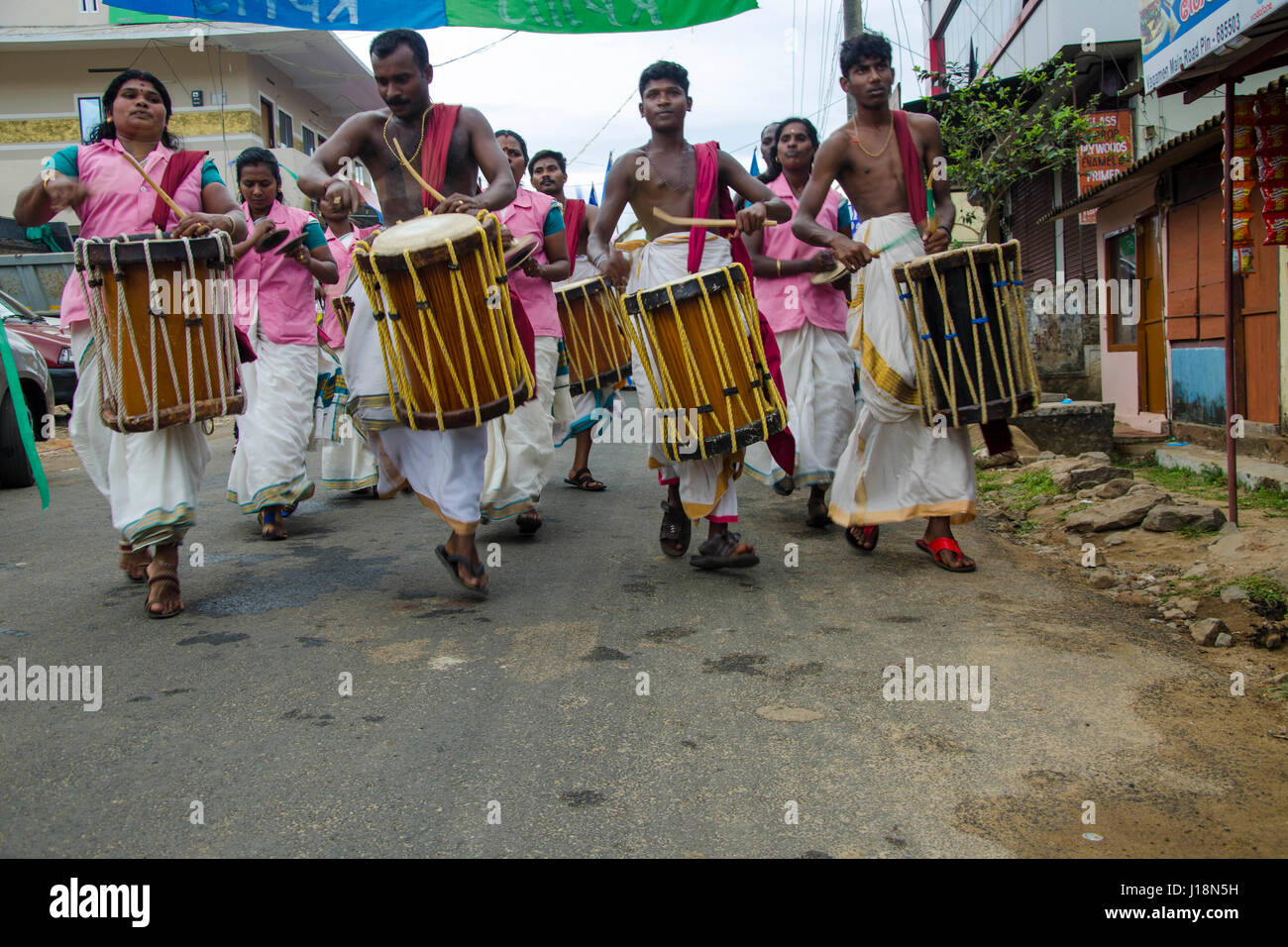Chenda Instrumental Music

Me & My friends performing instrumental music for charity program in London.
Chenda and Koal (stick) (ചെണ്ടയും കോലും) The Chanda (: ചെണ്ട, ) is a cylindrical instrument used widely in the state of, Tulu Nadu of and in India. In Tulu Nadu (Coastal Karnataka), it is known as chande.
This instrument is famous for its loud and rigid sound. A Chenda has two sides, the left side called ' (ഇടം തല)(Left Head) and the right side ' (വലം തല)(Right Head). The 'Edamthala' is made of only one/two layer of cow skin and the 'Valamthala' will have a five/seven layer skin, so as to have a sound. The skin are dried under shadow and fastened on wooden rings (Chenda Vattam, ചെണ്ട വട്ടം) made of the trunk of a locally available (Eeranpana) or bamboo, using a gum prepared from the seed of a tree called 'pananchi maram'. The circular frame is kept in a vessel, boiled for an entire day and then bent in the form of circle and dried up.
The body of the Chenda which is 1 ft in diameter and 1.5 inches thickness is made of the soft wood of the (വരിക്ക പ്ലാവ്) (Varikka Plavu). The thickness is again reduced by 0.25 inches, at simultaneous points separated by 4 inches. This is done in order to produce highly resonating sound.
Only the wooden rings with the skin (Chenda Vattam) is replaced once the quality of the sound is not up to the mark. For regular Chenda artists an average of 15 rings are required every year.
The Chenda is mainly played in temple festivals and as an accompaniment in the religious art forms of Kerala. The chenda is used as an accompaniment for,,, and among many forms of dances and rituals in Kerala. It is also played in a dance-drama called (Tenku Thittu) which is popular in Tulu Nadu in Karnataka. There is a variant of this instrument used in northern school of Yakshagana called. It is traditionally considered to be an ((demonic instrument)) which means it cannot go in harmony. Tesv exe 0xc00000ba hatas.
Chenda is an unavoidable musical instrument in all form of cultural activities in Kerala. Contents • • • • • • Types of Chenda [ ] Chendas are of different types, depending upon the diameter of the 'Chenda Vattam' (ചെണ്ട വട്ടം) they are called 'Ettara Veechan Chenda' (എട്ടര വീച്ചാൺ ചെണ്ട) (8.5), 'Ompathu Veechan Chenda' (ഒമ്പത് വീച്ചാൺ ചെണ്ട) (9), 'Ompathe Kal Veechan Chenda' (ഒമ്പതേക്കാൽ വീച്ചാൺ ചെണ്ട)(9 1/4), 'Ompathara Veechan Chenda' (ഒമ്പതര വീചാൻ ചെണ്ട)(9.5), 'Ompathe Mukkal Veechan Chenda' (ഒൻപതേ മുക്കാൽ വീചാൻ ചെണ്ട) (9 3/4), 'Ompathe Mukkal Kali Chenda' (ഒൻപതേ മുക്കാൽക്കാലേ വീചാൻ ചെണ്ട)(> 9 3/4 but. Chenda Melam led by A 'Chenda Melam' means using Chenda. The Chenda is used as a percussion instrument for almost all art forms like,, etc. Chenda melam is the most popular form in Kerala, for more than 300 years. A Chenda melam is an integral part of all festivals in Kerala.

There are 7 types of 'melangal' viz, Champa, Chempada, Adantha, Anchadatha, Druvam. The earlier 6 melams are called 'Chempada melangal'. Other than these seven 'melams' two more melams are there in Kerala 'Navam' and 'Kalpam'. The 'Chenda Vattam' or the skin used on Chenda should be very thin for classic Chenda Melam like, or for but for Chenda the 'Chenda Vattam' are hard, which are very cheap to make. 'Shingari Melam' is not considered as a classical form of art. Learning [ ].
Shinkari Melam A Chenda is taught in a traditional way, the students have to practice on a stone or wood using a strong and thick stick usually made of bark. The learning stick would be 29cm in length, 3 cm in diameter on one side and 2.5cm on other side of the stick. Once the learning on stone is finished, students learn on (വീക് ചെണ്ട) or the (വലം തല) part of the Chenda which is made of multiple layer of skin. The 'Valam Thala Chenda' is played using a long and thin stick. Once the students master to play on 'Valam Thala Chenda', the students start learning on the (ഉര്രുട്ട് ചെണ്ട) or the (ഇടം തല) part of the Chenda which will have only one layer of skin. While striking on a Chenda with two sticks, the stick on the right hand is hit on the upper part (little above the center part) of the 'Chenda Vattam' and the stick on the left hand is hit on the lower part (little below the center) of the 'Chenda Vattam'.